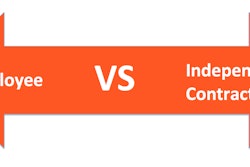Worker misclassification is an all too frequent problem in the construction industry. Unfortunately, it can have grave consequences. Because the worker classification issue has genuine tax ramifications, federal and state regulators view misclassification liability as an important revenue source in a down economy.
What is misclassification? In simple terms, misclassification occurs when an employer deems a worker to be an independent contractor despite the fact that the worker meets common law or statutory definitions of "employee."
Classification issues most often arise with income tax withholding or employee compensation. Thus, the tests developed by the IRS and the Department of Labor are most widely used to analyze these issues. The IRS uses a 20-factor test to determine whether a worker is an employee or an independent contractor. The Department of Labor uses an "economic realities" test, which although similar to the IRS test may put greater or lesser weight on certain factors. When classification issues are taken up at the state level, often the common law "right to control" test is adopted.
The state common law test looks at whether or not the supposed employer exercises authority over the worker and the basis for that authority. In general, if the worker is specifically told how to do the work and supervised in that process, the worker is more likely an employee rather than an independent contractor. If, in contrast, the worker is merely asked to produce an outcome without specific direction or oversight, then the worker is more likely an independent contractor.
The IRS's 20 factors can be divided into three major categories. The first category includes factors that focus upon behavioral control over the worker, for example, whether training is given to the worker, how the worker's output is evaluated, the level and scope of instruction given, etc. The second category of factors looks at financial control. Here, the factors include how the worker is paid, whether the worker invests in the project, who pays for tools or supplies, who bears the risk of loss or delay, etc. The third category looks at the relationship between the parties and examines factors such as whether there is a written agreement, the duration of the arrangement, whether the worker gets benefits, etc. In the IRS analysis no one factor or category of factors is paramount; rather, all of the factors are separately assessed.
The Department of Labor test adopts many of the factors in the IRS test but does not set out a clearly defined formula for which factors are used or how they are weighted. This test also incorporates the common law "right to control" test along with a focus upon economic factors such as whether the worker invests in the project, who bears the risk of loss and who pays for tools or supplies.
Misclassification consequences
The economic consequences of misclassification can be enormous. Where a worker is incorrectly deemed an independent contractor, the employer can become liable for back withholding of income taxes, plus penalties and interest.
Misclassification can have other legal consequences as well. If Immigration and Customs Enforcement (ICE) learns an employer deemed workers to be independent contractors when in fact they were employees, ICE will typically impose penalties for missing I-9 forms and may also impose penalties for "knowing employment" violations. In such cases, ICE will often assert the reason the employer misclassified the worker was because the employer knew the individual lacked authorization to work in this country. Missing I-9s can result in penalties of up to $1,100 per form; knowing employment violations can cost as much as $3,200 per individual. Employers found to have violated the knowing employment prohibition might also lose their federal and/or state contracts, or in severe cases face criminal liability for immigration violations.
Employers may also face liability for worker's health care costs and other "insured" benefits. For example, a misclassified worker who suffers an on-the-job injury may not be covered by worker compensation insurance, in which case the employer might become liable for the direct costs associated with the worker's injury. Similarly, if the employer's regular employees are eligible for other benefits, a misclassified worker may claim eligibility for those same benefits, which could result in a sudden and catastrophic cost to the employer. Finally, in some cases, when misclassified workers are added to the employer's normal headcount, the employer may become covered by antidiscrimination legislation, which can also expose the employer to additional liabilities.
Recently, IRS has begun cracking down on misclassification. Often, this leads to multi-agency investigations that result in a grand jury indictment against the employer and its principals. All of this suggests that prudent employers will carefully consider the foregoing factors when making classification decisions.



















